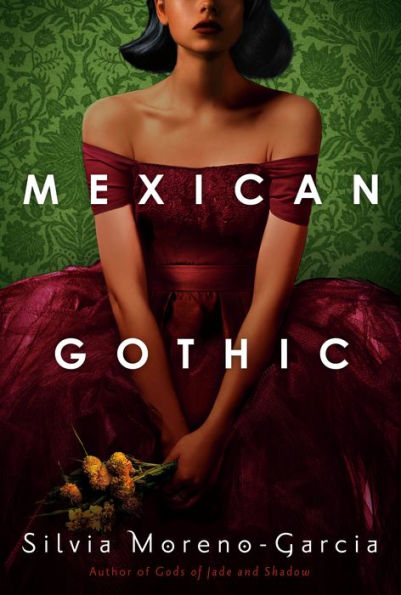The timeless story of the gothic haunted house looms in the literary imagination across generations of storytellers, creating a physical and psychic space where the literal and metaphysical ghosts of a home, and a family roam. It is a story that I am drawn to time and time again. I recently found myself gathering my own canon of haunted house stories from book, films and TV shows for my own creative obsession, revisiting the Woman in Black by Susan Hill, Shirley Jackson’s The Haunting of Hill House (and obsessing over the beautifully haunting adaptation from Mike Flanagan). The modern interpretations of the gothic haunted house are endless, from the story of the Winchester Mystery House (and the 2018 film starring Helen Mirren), American Horror Story: Roanoke, and many others. The haunted house is a space where secrets and trauma lie, where reality and time becomes blurred, and where who one can trust is constantly under question, including whether the people who inhabit the house can trust themselves and their own senses.
And of course, there is the gothic heroine trying to escape the haunted house or be consumed by it. This is where Mexican Gothic, the latest novel from Silvia Moreno-Garcia, shines.
The gothic heroine of this novel, Noemi Taboada, is a young and beautiful anthropology student and socialite from Mexico City who is tasked by her father with travelling to the remote mountain town of El Triunfo to check in on her cousin, Catalina, who was recently married to an Englishman, Virgil Doyle, in a whirlwind romance and has since written a letter to her uncle, who is like her surrogate father, that disturbs and worries him. He suspects that Catalina is ill, or being mistreated. Though Noemi is reluctant to go, thinking that her father is perhaps blowing the situation out of proportion, she agrees out of worry for her cousin.
From the moment that Noemi arrives at High Place, the English manor house of the Doyles, transplants and owners of a deteriorating silver mine set far up in the mountain and away from the local towns peoples, she is beset with unease about the home where Catalina is living and the Doyle family. While the novel takes place in the 1950’s, it appears that time has stood still in the house. “The house loomed over them like a great, quiet gargoyle. It might have been foreboding, evoking images of ghosts and haunted places, if it had not seemed so tired,” is the first description of the house, and this is a wonderful nod to traditional gothic stories where the family living in a house is haunted by the past, and therefore stuck in it. Noemi, who represents the vibrance of a confident and healthy young woman, is immediately at odds with the Doyles. Virgil, her cousin’s husband, is pleasant but leering, and makes her uneasy to be around him. Florence, his elder aunt, is cold and resentful that Noemi is even there and does whatever she can to prevent Noemi from seeing Catalina, claiming that she is recovering from a bout of tuberculosis and needs plenty of rest. The patriarch of the family, Howard Doyle, is in ill health, but manages to disgust Noemi upon their first meeting when he challenges her academic knowledge of anthropology and spouts beliefs about eugenics and how to utilize indigenous genes and labor while keeping their English bloodlines pure. Noemi’s only ally in the house is Francis, the youngest Doyle, who is kind and helpful to her under the nose of his hawkish mother Florence.
Buy the Book


Mexican Gothic
It was difficult for me to enter the book wholeheartedly at first, as I felt in the beginning that I was being told who Noemi was as a socialite who couldn’t decide whether she wanted to party with handsome young men or pursue her studies against her father’s expectations for what was an appropriate life for a young woman like herself. I liked that, as a young Mexican woman, Noemi is represented as scholarly, curious and also tenacious and interested in living her life freely, but at times, she also serves as a repository of knowledge for the story that was sometimes overused. As a Mexican American woman, I also found disengaged when the book explained facets of urban and rural Mexican culture rather than making it feel like a natural part of the setting and Noemi as a character. Maybe this is to set Noemi as a direct contrast to the characters she encounters at High Place. When Noemi travels to High Place, that is where the story really began for me, as this is when we get to see Noemi’s personality and how she comports herself in this hostile situation in order to advocate for her cousin Catalina, who goes between being practically catatonic to awake and lucid but describing terrible dreams about the house and how it feeds off of her energy. If Noemi is the gothic heroine fighting against the haunting of the house, then Catalina is the “madwoman in the attic,” kept bedridden by the family and disbelieved. The house itself feels alive with the history of the Doyle family, but more than that, with pain and the spirits of the past that cannot rest. As Noemi explores the house, the grounds and family cemetery beyond, she begins to understand the tragedies that have befallen the family and the people there, and why the townspeople of El Truinfo distrust the Doyle family.
The most engaging and beautifully disturbing parts of the novel are when Noemi dreams, in which she sees the lifeforce of the house in the living walls (a great nod to the narrator in the Yellow Wallpaper). It is through these dreams that she slowly understands the house as a living organism that calls out to her in her nightmares, revealing what happened to the family after the deaths of Howards two former wives who were as disposable to him as anyone else, and the violence enacted against the family by Ruth, Howard’s daughter, to escape his tyranny. It is Ruth that calls out to Noemi in her dreams, causing Noemi to walk the house in her sleep. Ruth warns her and implors her to see the truth about the family. Despite Florence’s interventions, Noemi reaches out to local doctors and a healer in town at Catalina’s request to gain access to a tincture that might lift the sickness that Catalina suffers from. What Noemi discovers is that the house is more than haunted by the spirits of the dead, but by a hivemind that contains the memories, spirits and lifeforce of the Doyle family. This is a twist on the haunted house that felt new and original, and one that I appreciated. The family is physically alive, but inextricable from the house.
Noemi’s fight throughout the novel is not just for the health of her cousin, but against the erasure of Catalina as a person, when she is so often treated as an invalid and an object to be used. As Noemi stands in the Doyle family graveyard, she thinks, “If Catalina dies, she’ll be buried here, and her tomb will be bare,” and it is one of the saddest moments of the book. Noemi and Catalina must both fight the hold of the house, tying them to Howard Doyle and his lascivious desires to continue his family line at whatever cost in pursuit of eternal life. Be warned that there are very disturbing scenes of sexual assault, massacres of indigenous peoples, and violence done to women and children that are deeply disturbing. At times, these moments compress the Doyles into archetypal villains that are fairly irredeemable, but I don’t know that it would serve the story, or the reader, to feel sympathetic to the overt misogyny and racist violence of Howard Doyle. Even Francis, who aids Noemi and even becomes her romantic interest, is both a victim of the oppression of the house, and complicit in the violence of his great uncle Howard.
The book’s homage to gothic stories in a culture and setting that has not been as widely explored before and the risks that it takes are engaging, and Noemi’s will to vanquish Howard Doyle and free herself, Catalina and even gentle Francis from the house kept me reading. If you are looking for a new take on the haunted house story for your own growing canon, Mexican Gothic is worth the exploration.
Mexican Gothic is available from Del Rey.
Leticia Urieta is proud Tejana writer from Austin, TX. She works as a teaching artist in the Austin community. She is a graduate of Agnes Scott College and holds an MFA in Fiction writing from Texas State University. Her work appears or is forthcoming in Cleaver, Chicon Street Poets, Lumina, The Offing, Kweli Journal, Medium, Electric Lit and others. Her chapbook, The Monster is out now from LibroMobile Press. She is currently at work completing her novel that tells the story of a Mexican soldadera caught up in the march to Texas during Texas’ war with Mexico.










